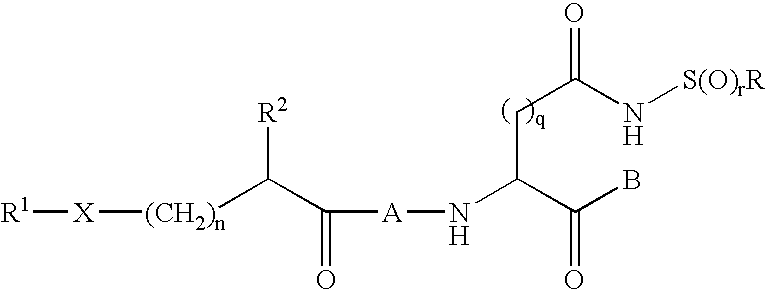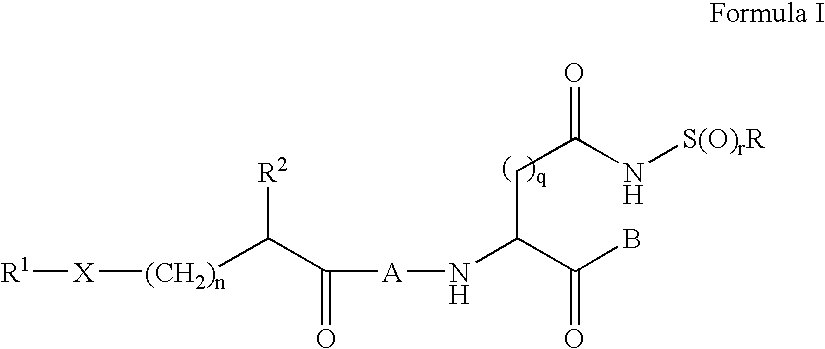Inhibitors of the ICE/ced-3 family of cysteine proteases
- Summary
- Abstract
- Description
- Claims
- Application Information
AI Technical Summary
Benefits of technology
Problems solved by technology
Method used
Image
Examples
example 1
Assay for Inhibition of ICE / ced-3 Protease Family Activity
A. Determination of IC50 Values
[0161]Fluorescence enzyme assays detecting the activity of the compounds of Formula I utilizing the recombinant ICE and CPP32 enzymes are performed essentially according to Thornberry et al. (Nature 356:768:774 (1992)) and Nicholson et al. (Nature 376:37-43 (1995)) respectively, (herein incorporated by reference) in 96 well microtiter plates. The substrate is Acetyl-Tyr-Val-Ala-Asp-amino-4-methylcoumarin (AMC) (SEQ ID NO: 1) for the ICE assay and Acetyl-Asp-Glu-Val-Asp-amino-4-methylcoumarin (SEQ ID NO: 2) for the CPP32, Mch2, Mch3 and Mch5 assays. Enzyme reactions are run in ICE buffer (25 mM HEPES, 1 mM EDTA, 0.1% CHAPS, 10% sucrose, pH 7.5) containing 2 mM DTT at room temperature in duplicate. The assays are performed by mixing the following components:[0162]50 μL ICE, Mch2, Mch5, CPP32 (18.8, 38, 8.1 and 0.153 nM concentrations, respectively) or Mch3 (1 unit) enzyme in ICE buffer containing ...
example 2
Synthesis of Representative Compound
[0167]
Bromomethylketone (2):
[0168]4-Methylmorpholine (0.75 mL, 6.8 mmol) was added to a solution of Fmoc-Asp(OBn)-OH (1) (2.03 g, 4.55 mmol) in 50 mL of dry THF at −10° C. under an atmosphere of nitrogen, followed by the addition of isobutyl chloroformate (0.78 mL, 6.0 mmol), and the solution was stirred for 20 minutes. The resulting white precipitate was removed by filtration and the filtrate was cooled to 0° C. In a separate flask, 1-methyl-3-nitro-1-nitrosoguanidine (1.08 g, 7.36 mmol) was added to a vigorously stirred mixture of diethyl ether (14 mL) and 40% KOH (8 mL) at 0° C. The resulting mixture was stirred for 10 minutes and the layers were allowed to separate. The ether layer was transferred via plastic pipette to the original filtrate in THF and the reaction mixture was stirred for 30 minutes. Then, 48% HBr in water (2.10 mL) was added and the reaction mixture was warmed to room temperature over 15 minutes. The solution was diluted with...
example 3
Alternative Synthesis of Compounds of Formula I
[0180]This example illustrates synthesis of compounds of Formula I by formation of a stabilized sulfonamide ring, followed by addition via amide bond formation to the remainder of the compound. In the following representative examples, q is 1, r is 2 and R is methyl.
[0181]Starting with the commercially available Z-Asp(OtBu)-OH, the Weinreb amide is formed, followed by hydrolysis of the t-butyl ester. The beta carboxylic acid is then coupled with methyl sulfonamide (or other substituted sulfonamide), followed by reduction of the Weinreb amide to the aldehyde. Acid-catalyzed acetal formation using ethanol is assisted by cyclization of the sulfonamide to form a stable 5-membered ring. The carbobenzyloxy urethane is then removed, the aspartyl intermediate coupled to the substituted acyl peptide of choice, then the acetal deprotected. (a) EDCl, HOBt, N-Me Morpholine, HClH2N(OCH3)CH3, CH2Cl2, 0° C.-RT; (b) TFA, anisole, CH2Cl2, RT; (c) EDCl,...
PUM
| Property | Measurement | Unit |
|---|---|---|
| Structure | aaaaa | aaaaa |
Abstract
Description
Claims
Application Information
 Login to View More
Login to View More - R&D
- Intellectual Property
- Life Sciences
- Materials
- Tech Scout
- Unparalleled Data Quality
- Higher Quality Content
- 60% Fewer Hallucinations
Browse by: Latest US Patents, China's latest patents, Technical Efficacy Thesaurus, Application Domain, Technology Topic, Popular Technical Reports.
© 2025 PatSnap. All rights reserved.Legal|Privacy policy|Modern Slavery Act Transparency Statement|Sitemap|About US| Contact US: help@patsnap.com



